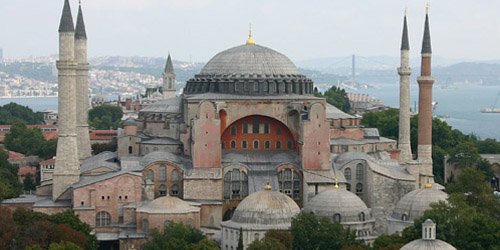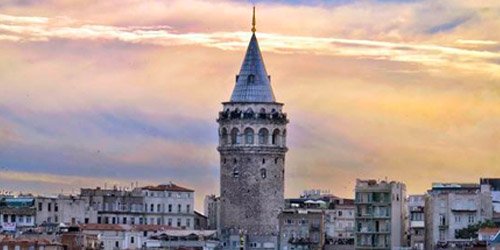Traveling Places of Istanbul Turkey
Aya Sofya
It’s said that when the Byzantine Emperor Justinian entered his finished church for the first time in AD 536, he cried out “Glory to God that I have been judged worthy of such a work. Oh Solomon, I have outdone you!” The Aya Sofya (formerly the Hagia Sophia) was the emperor’s swaggering statement to the world of the wealth and technical ability of his empire. Tradition maintained that the area surrounding the emperor’s throne within the church was the official center of the world.
Through its conversion to a mosque, after the Ottoman armies conquered Constantinople, to its further conversion into a museum in the 20th century, the Aya Sofya has remained one of Istanbul’s most cherished landmarks.

Topkapi Palace
First built by Mehmet the Conqueror in the 15th century, this glorious palace beside the Bosphorus was where the sultans of the Ottoman Empire ruled over their dominions up until the 19th century. The vast complex is a dazzling display of Islamic art, with opulent courtyards lined with intricate hand-painted tile-work, linking a warren of sumptuously decorated rooms, all bounded by battlemented walls and towers.
Of the many highlights here, the most popular are the Harem (where the sultan’s many concubines and children would spend their days); the Second Court, where you can walk through the vast Palace Kitchens and stand in awe at the dazzling interior of the Imperial Council Chamber; and the Third Court, which contained the sultan’s private rooms.

Blue Mosque (Sultan Ahmet Camii)
Sultan Ahmet I’s grand architectural gift to his capital was this beautiful mosque, commonly known as the Blue Mosque today. Built between 1609 and 1616, the mosque caused a furore throughout the Muslim world when it was finished, as it had six minarets (the same number as the Great Mosque of Mecca). A seventh minaret was eventually gifted to Mecca to stem the dissent.
The mosque gets its nickname from its interior decoration of tens of thousands of Iznik tiles. The entire spatial and color effect of the interior makes the mosque one of the finest achievements of Ottoman architecture. A great sightseeing joy of a trip to Istanbul is wandering amid the gardens sandwiched between the Blue Mosque and the Aya Sofya to experience their dueling domes in twin glory. Come at dusk for extra ambience, as the call to prayer echoes out from the Blue Mosque’s minaret.

Basilica Cistern (Yerebatan Sarniçi)
The Basilica Cistern is one of Istanbul’s most surprising tourist attractions. This huge, palace-like underground hall, supported by 336 columns in 12 rows, once stored the imperial water supply for the Byzantine emperors. The project was begun by Constantine the Great but finished by Emperor Justinian in the 6th century.
Many of the columns used in construction were recycled from earlier classical structures and feature decorative carvings. The most famous of these are the column bases known as the Medusa stones in the northwest corner with their Medusa head carvings. A visit here is very atmospheric with the columns beautifully lit and the soft, steady trickle of water all around you.

Grand Bazaar
For many visitors, sightseeing in Istanbul is as much about shopping as museums and monumental attractions, and the Grand Bazaar is where everyone comes. This massive covered market is basically the world’s first shopping mall, taking up a whole city quarter, surrounded by thick walls, between the Nure Osmaniye Mosque and Beyazit Mosque. The Beyazit Mosque (built in 1498-1505) itself occupies the site of Theodosius I’s Forum and has architecture inspired by the Aya Sofya.

Süleymaniye Mosque
Sitting high on the hill above Sultanahmet district, the Süleymaniye Mosque is one of the most recognized landmarks of Istanbul. It was built for Süleyman the Magnificent by the famed Ottoman architect Sinan between 1549 and 75. The interior, dominated by its soaring 53-meter-high dome is notable for its harmonious proportions and unity of design. Outside in the tranquil garden area is an interesting Ottoman cemetery that is also home to the türbes (tombs) of the Sultan Süleyman and his wife Haseki Hürrem Sultan (known in the west as Roxelana).

Dolmabahçe Palace
The sumptuous and ornate Dolmabahçe Palace shows the clear influence of European decoration and architecture on the Ottoman Empire in the 19th century. Built by Sultan Abdülmecid I in 1854, it replaced Topkapi Palace as the main residence of the sultans. The formal gardens are punctuated with fountains, ornamental basins, and blooming flower beds, while inside the sheer splendor and pomp of the Turkish Renaissance style is dazzling. The interiors mix Rococo, Baroque, Neoclassical, and Ottoman elements, with mammoth crystal chandeliers, liberal use of gold, French-style furniture, and dazzling frescoed ceilings.

Galata Tower
This Genoese tower was built in the 14th century and is one of Istanbul’s most recognizable landmarks. Take the elevator or the stairs for great panoramic views over the city from the top balcony. Be aware, though, that it’s a super popular sight, so come early or be prepared to wait in line.

Istiklal Caddesi and Taksim
Pedestrianized Istiklal Caddesi (Independence Street) is a bustling modern shopping street with a wealth of restaurants and cafés. The lower end of the street can be reached by taking the world’s oldest underground railway from near Galata Bridge, the Tünel, constructed in 1875. There is also a quaintly old-fashioned tramway that runs along its length right up to Taksim Square at the top of the hill. From Taksim Square, busy Cumhuriyet Caddesi is lined with hotels, shops, restaurants, and high rises. On the east side of the road, just after the square, is Maçka Park, which is home to the interesting Military Museum.











